
NPS Photo Thank you for visiting Rocky Mountain National Park's official west side blog, West Side Stories. Home to the Colorado River and abundant with life, the valley provides an area for moose and elk to graze, wild flowers to grow and fish to swim. It is a place where many animals choose to live and I'm fortunate enough to live there as well. West Side Stories focuses on Rocky Mountain National Park's west side, localed near Grand Lake, CO. In this blog you will find entries from the staff, with a goal of presenting you with a well-rounded understanding of our area. Although you may not be able to visit the park on a daily basis like those of us working here, this blog will give you the chance to regularly experience it through our words. Check back frequently for our most recent adventures! 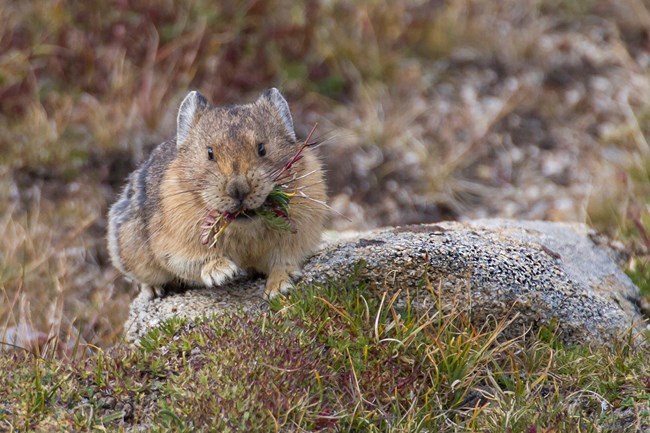
VIP Ann Schonlau Alpine CrittersFebruary 3, 2018 Elk and moose are the main draw to our side of the park, but there are two other animals that hold a bigger spot in my heart. These smaller creatures bring such delight when I manage to spot their elusive forms among the rocks as I hike in the stunning alpine tundra. Hiking up the mountains, the songs of birds in the trees are replaced by the squeaking and skittering of the pika and whistles of the marmots. Sometimes these two can be spied from the roadside in the mornings or evenings, but mostly they are found after working up a sweat hiking up to their homes. Pika, being the smallest at an average of 6 inches in length, are members of the rabbit family even though they look very similar to mice. The soft grey fur covers every part of their body including their five toed paws. Rock crops provide housing areas for these solitary creatures. I usually spot them scurrying around the vegetation gathering bundles to make into hay piles. During their gathering, they fill the alpine with noise as they squeak and chirp to scare off neighbors as well as to warn of predators. These noises are often frustrating as I desperately search for some movement but only hear their calls. I delight in being able to spot the tiny pika as they bustle over the tundra with bundles in their mouths. They have adapted so well to living in such a cold environment they make excellent species to study for changes in climate. Warmer temperatures may push their territories further up the mountains as well. Territories may become more separated and inbred as the lower elevations for travel between mountain ranges may become inhospitable. Alpine species such as the American pika are adapted to the severe winters and short mild summers of the tundra. Increasing temperatures and decreasing snowpack could have significant impacts on pika populations in the park. Pika are fiercely defensive of their territory. Fighting off all invaders, including their own offspring as soon as they are weaned, in order to protect their food sources. The first summer for new pika sees more than a fifty percent mortality as they search for territory as well as having to stock up stores for the winter months ahead. As they do not hibernate they must gather enough food to last them through the long, cold winters. It is hard to keep track of them for long viewing periods as they busily dart amongst the rocks, but the marmots provide ample opportunities for lingering observations.
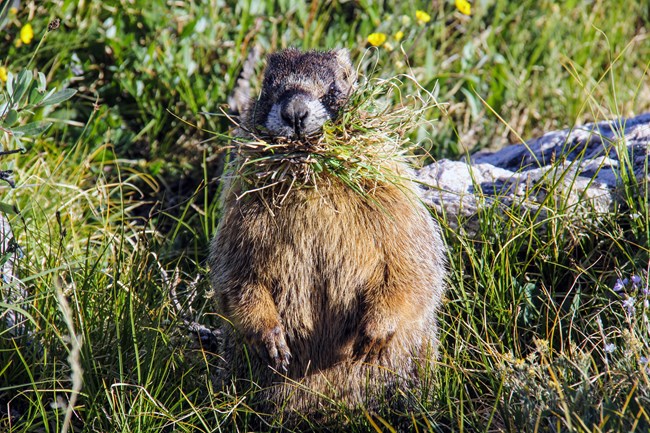
VIP Bonnie Beach The marmots always bring a wide grin of joy when I spot their portly figures lounging in the rocks. They seem like such passive creatures as they lazily bask in the sunshine for the few months they are out of their dens. The largest member of the squirrel family they can be up to two feet long and 11 lbs. Looking much like their relatives the groundhogs, they have reddish brown fur with yellow bellies. Hibernation can take up over half their year, making the few months they are awake precious for bulking up for the next winter. They live in colonies of 10-20 with one dominant male, multiple females and yearlings until they are pushed away. These colonies can degrade into violence amongst the members, especially the females killing other young, as they protect their share of food. When danger is present, they emit a loud whistle which can startle you as you are hiking along, earning them their nickname of “whistlers”. Marmots rarely seem to work up the energy to move quickly, but it is a wonderful hoppy gait that gets them to safety in their nearby tunnel systems. One ranger tells a story of the marmots he watched for upward of twenty minutes when he stumbled upon it on one of his hikes. During that time, the marmot laid in one spot, reaching out with a paw to gather vegetation to eat. Once he successfully ate a circle clear around him, he struggled to reach another clump and simply gave up. They have a place in my heart for the sheer joy of watching them make their way unperturbed through life. Next time you find yourself in high rocky outcroppings, make sure to keep your eyes peeled! 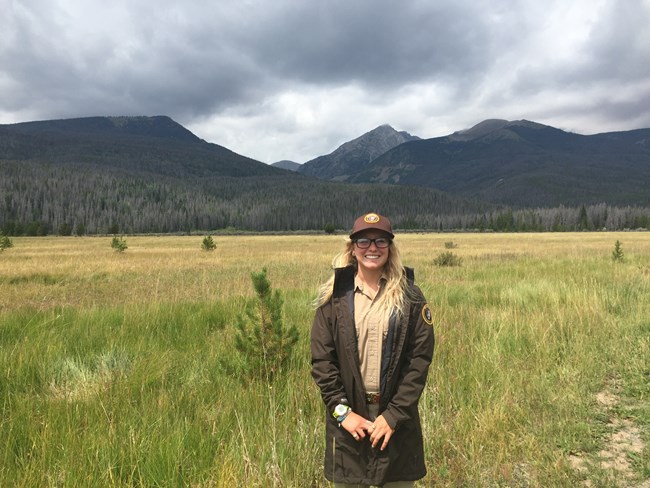
Not Your Typical Internship: The Life of a Rocky Mountain National Park InternNovember 15, 2016 The word “intern” echoes in the back of your mind, eliciting harsh memories of pointless paperwork, mundane tasks, and those dreaded morning coffee runs. Or maybe you've never had to face the dreaded “intern” status, the attempt to market yourself, to network with other peers, and to develop a career? Scary stuff. But shouldn't an internship be more than just filing papers, filling coffee cups, and networking? Personally, I think the answer is yes. Within the National Park Service, the duties of an interpretive intern rarely involves any of the “traditional” intern responsibilities, which I learned before I finished my first week. The first day on the job was the typical meet and greet: “This is so and so, head of this and that.” “This is the standard operating procedure for this.” And the all-important: “Here’s where we make the coffee. 3 scoops for one full pot.” 
But once that first day in the Kawuneeche Visitor Center was done, the internship became a totally different animal. Over the next few weeks I shadowed programs I would be leading, patrolled the trails and talked with visitors, learned how to use the radio, got up close and personal with some of the more furry residents of the park, and tried to learn all the names of the many volunteers, rangers, and coworkers. I was honestly a little overwhelmed. I spent a good a majority of the 3-day drive from Pennsylvania to Colorado studying all the books and binders and pamphlets I received in the weeks before, and I quickly learned that nothing can supplement the real thing. Once I had a crash course in being an interpretive intern on the west side of Rocky Mountain National Park, I started to realize this wasn’t going to be your typical internship. Between the roving or leading programs, I’m outside for most of the day. I don’t sit at a desk—I hike. I get the chance to make a person's visit special and memorable. I use interpretative skills to excite visitors, to share stories and discuss history, to allow them to question things, and to share a deeper meaning and deeper connection to their surroundings. Being an interpretative intern for Rocky Mountain National Park is truly a unique experience. Throughout this internship, I hope to enhance my professional skills but also to gain new skills within interpretation, environmental education, and natural sciences. I cannot put into words how much I am already learning, how generous and genuine my coworkers are, and how memorable this experience is. Here you are not just a kid that fetches coffee; you are a valued piece of the puzzle, which is making my experience here so special. 
November 2, 2011 
NPS Photo As the season starts to wind down so does activity at Rocky Mountain National Park (RMNP). Everything seems to move a bit slower as the number of visitors decline. It begins getting colder earlier in the day and warmer later; the Earth begins preparing for winter. Bears are looking for enough food to survive through their long naps and the bitter cold. The rivers' and streams' water levels drop or completely dry up, waiting next years run off. The aspen leaves become glowing patches on the mountainsides, while the elk band together in the lowlands to avoid the extreme weather. Here I sit writing this blog, thinking about how I must began preparing myself as well. I will soon be leaving my temporary home in Rocky Mountain National Park. My season is ending, and as the warmth of the summer months escapes the mountains, I'll be leaving with it. Even though I will not be living in the park during the winter, I am fortunate to be able to visit it this year. I'm looking forward to seeing the park in a new light. One that is less forgiving and less traveled. The snow in RMNP seals some areas of the park away from many travelers. An area that was once bustling with people will soon become still with only the animals and maybe a few souls to witness the events that take place. 
NPS Photo You can't truly know an area until you have witnessed it in all of its seasons. Like a friend, you've never seen happy or sad, there is still a personality to this park I've not yet greeted. October 18, 2011 
NPS Photo Enos Mills, John Muir, Theodore Roosevelt, Thomas Moran, and other pioneers of national parks saw, in the words of Jeff Rennicke, our national postcards in these wild places. They saw the Sistine Chapel in the sheer face of Half Dome, the Cathedral of Notre-Dame de Paris in the giant sequoias, the Roman Aqueducts in Old Faithful. This young country was establishing its international worth not through its examples of mankind's ingenuity, but through its examples of untrammeled wildness. 
NPS Photo There is a reason that 281,303,769 people from around the world visit the 58 national parks and 337 additional National Park Service units and why almost 100 countries have followed suit and created similar systems to protect their own wild lands. There is something inexplicable about the sense of freedom, calm, adventure, peace, joy, awe, connection, or any number of other emotions that many of us experience when roaming our natural environment. National parks are playgrounds not only for our adventurous spirits and wanderlust feet, but for our imaginations as well. National parks are places where it is socially acceptable, even highly encouraged, for adults and children alike to delight in the sprightly path of a chipmunk, pass nights gazing in awe of the starry sky, or make tree identification a fully sensory experience. There is no one right way to enjoy national parks (as long as all rules are being followed, but again, matter for another post) - there are loads of opportunities for visitors to learn all about the flora, fauna, geology, history, and management of their park, but there will be no tests, no homework, only deeper understanding … and that's why I'm here. As an Intern in Rocky's west side Interpretation Division, I am here to help visitors more fully understand why our waterfalls and flowers and rocks and critters of all shapes and sizes are so worthy of our attention and protection. 
NPS Photo Sometimes when I'm walking to the Kawuneeche Visitor Center in the morning, listening for elk bugling in the distance and watching the frosted aspen leaves thaw in the rising sunlight or when I'm diving into research about exactly why the park's moose like the west side so much, I just have to stop. I live in a national park. This is my job. Some days I spend the afternoon talking with people on trail or in the visitor center about the elk rut, and the evening helping those same elk cross Trail Ridge Road. It is my duty to know the park and interpret its significance to visitors, so I spend my days hiking, talking with first time and veteran visitors and staff, and reading all about park history, policy, and management. Many people I talk with think that this must be an awesome job (and it is!), but there is more to working in - and visiting - a national park than reveling in picture-perfect sunsets and pondering the tracks left from critters' morning hikes. To go to a national park is to support a national park and thus to support all it stands for - conservation, sustainable use, protection of the country's most precious resources. National parks would not exist without people - people who visit them, support them, protect them, work in them, study them, maintain them, and all the people in between - and I dare say that people would be different without national parks. Our National Park System doesn't only preserve significant natural and historic sites; it preserves a fundamental understanding of who we are as a people. And I'm not only talking about Americans who better understand our culture upon seeing the Statue of Liberty or Gettysburg, I'm talking about people from any state or country, who speak any language or live in any culture, and who fall anywhere on the outdoorsy spectrum who visit and are changed by national parks. Whether they leave more calm, enlightened, fit, or informed, whether they snapped the photo of their life, climbed a mountain, conquered a fear, or learned something new, national parks allow us to look beyond the everyday, to marvel in the extraordinariness of nature, humanity, and ourselves. And that seems like a pretty good idea to me. 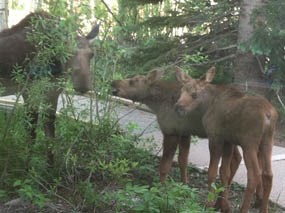
NPS Photo July 14, 2011 
NPS Photo Moose calves are usually born in May or June and stay with their mothers for almost the entire year. Cow moose usually have only one offspring. I’ve read that having twins isn’t common, but it might not be as rare in Rocky Mountain National Park because of the plentiful food.
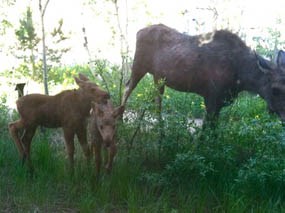
NPS Photo And about viewing wildlife,
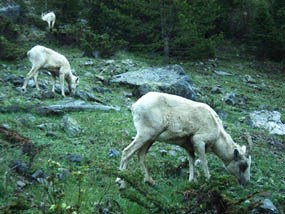
NPS Photo Keeping a distance from the animals helps keep wildlife wild and all of us safe. After all, the reason we visit national parks is to be in the wild, right? More information about park wildlife can be found on Rocky Mountain National Park’s Wildlife Viewing webpage. June 26, 2011 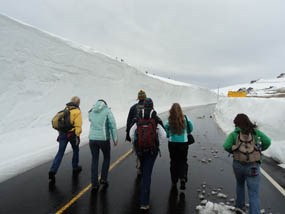
Training for the season with the rest of the Backcountry Office, started on the east side of RMNP. We have a lot of returning staff along with some great new additions to the office. As always, training was a rewarding experience. The highlight of my visit had to be our hike up Trail Ridge Road. Trail Ridge Road is always an amazing sight, but the abnormal snowfall made it extraordinary. The winds were incredible, nearly pushing us over, and the snow walls reached as high as 23 feet! As remarkable as the snowfall is, it also brings added elements of danger. While hiking, it is important to be aware of your surroundings. As the snowpack begins to melt avalanches become more common. If you plan to do backcountry camping, be sure you understand the winter camping regulations. It was a long winter, but it felt like it had been even longer since I’d put on my gray and green uniform. It feels natural and is an honor to wear the National Park Service uniform. On my first day of work as I hung my flat hat behind my desk, I realized I was back and this new chapter of my time in RMNP could now begin. 
Tuesday, November 30, 2010 Stop, Drop and Roll I immediately responded to the notification and proceeded to the area. Upon reaching the fire, I met up with a fellow ranger. Our first concern was to ensure the safety of RMNP's visitors. Drawn to the commotion and smoke, a large crowd had gathered hoping to gain a glimpse of the fire. Because the fire had become a threat, the visitors were asked to evacuate the area. Once the area was secure we were advised of two backcountry campers scheduled to stay the night at a campsite further up the Onahu Creek Trail. As a precautionary measure, I began hiking up the trail in an attempt to locate and evacuate the backpackers. The smoke was thick on the trail, and though smoke itself can be harmful there was no immediate threat of fire to the area. I passed two hikers while on my way to the campsite. I updated them on the current situation then continued to my destination. I arrived at the campsite and found no campers or signs of use. Because the area was clear I continued back down the trail to catch up with the hikers I had passed earlier. They seemed in good spirits and were actually excited about the wildfire and being "rescued." I continued to check with the hikers to make sure everything was ok. It turned out one of the backpackers was asthmatic and, due to the smoke, was beginning to have difficulty breathing. I reported the situation to fellow rangers who met the hiker at the Onahu Creek Trailhead to provide medical care. Thankfully, no one was hurt or injured during this fire, and due to the prompt reactions of several local agencies it was quickly contained. The Onahu Creek Fire burned approximately forty acres. It was amazing to watch how well organized RMNP was and the cooperation between the National Park Service and local fire departments. I am very proud to have been able to assist. While there are many stigmas against wildfires they are actually, if closely monitored, beneficial to the forest. An example of this can be found in the lodgepole pine, the most prevalent tree on the west side of RMNP. Many lodgepole pines have what is known as serotinous cones. Recognizable by their closed cone structure, serotinous cones can only be opened by high temperatures. High temperatures, such as would be found in a fire, melt the resin that seals the scales of the cone, thus releasing its seeds. Trees that produce serotinous cones are often found in forests where fire is a regular part of the environment. Many forest fires allow for growth, and in the case of the Onahu fire, the fire allowed for regeneration by clearing away dead and diseased trees making space for the new. If you're in the area, drop by the Kawuneeche Visitor Center to see some of the serotinous cones that were recently opened by the Onahu Creek fire! To learn more about the Onahu Creek fire and other happenings around the park please visit our website at https://www.nps.gov/romo/parknews/newsreleases.htm Monday, September 27, 2010 My Journey Thus Far When I first heard news that I got the job working in the Backcountry Office I was more than thrilled. Everyone I informed, no matter what his interest was in the outdoors, was ecstatic about the idea of working as a ranger in a national park. Like most, I had a preconceived notion of what life would be like working in RMNP. When one thinks of a park ranger, images of a cartoon bear and picnic baskets come to mind. However, I soon found out being a national park ranger meant more than what is commonly associated with Yogi and the gray and green uniform. I lived in Chicago, Illinois before moving to Colorado. The drive was long, over 1,000 miles, but it passed quickly. There is something special about traveling west to pursue new adventures; it's a classic journey. Once I arrived in Grand Lake, the town bordering the west side entrance, I went to the Kawuneeche Visitor Center to pick up the key to my rustic cabin. I was pleased to find the cabin was a part of the historic Green Mountain Ranch, built in the early 1900s, and is nestled in the Kawuneeche Valley. I knew this was going to be a great summer. The job began quickly. My training ranged from wilderness orienteering to interpretation skills. While I was well-versed in some of the activities, there was still a lot to learn. After the first few weeks, I had the chance to put my training to practice. I began to issue camping permits and patrol the backcountry, among other duties. Rangers are in the parks every day helping to create an experience for visitors and preserve the premiere natural areas in the country. At times a ranger's duty involves managing risk. In just the small amount of time I have worked at RMNP there have been multiple rescues where rangers have faced danger to assist someone in need. Our duties range from helicopter rescues to collecting entrance fees. All are necessary to preserve the park. Rangers are not the only people who help to preserve our National Parks. Everyone's involvement in the National Park Service is what makes our parks as amazing as they are. I have never felt more of a connection to a job before. I feel as though I'm a part of something larger than myself, a legacy of environmental stewardship that dates back to before the National Park Service was founded, to stewards such as John Muir. I leave you with a quote from John Muir,
Enjoy this west side blog and the insights you will gain from a variety of west-side staffers! |
Last updated: February 3, 2018
